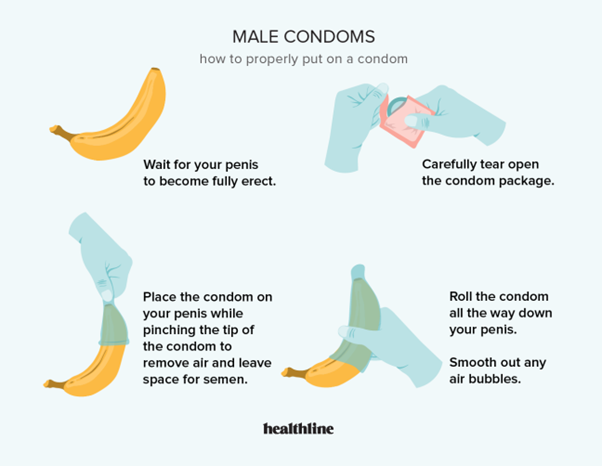A nurse is teaching a client about condom use. Which of the following client statements should the nurse identify as an understanding of the teaching?
"I can use natural-skin condoms to prevent sexually transmitted infections."
"I can use petroleum jelly as a lubricant with the condom."
"I can re-use the condom one time after initial use."
"I can store the condoms in the drawer of my nightstand."
The Correct Answer is D
Choice A reason
"I can use natural-skin condoms to prevent sexually transmitted infections." This statement is incorrect. Natural-skin or lambskin condoms are not recommended for preventing sexually transmitted infections (STIs). They may provide some protection against pregnancy but do not effectively protect against STIs. Clients should use latex or polyurethane condoms to reduce the risk of STIs.
Choice B reason
"I can use petroleum jelly as a lubricant with the condom." This statement is also incorrect. Petroleum jelly (Vaseline) and other oil-based lubricants can damage latex condoms, leading to a higher risk of breakage or failure. Clients should use water-based or silicone-based lubricants with latex or polyurethane condoms.
Choice C reason:
"I can re-use the condom one time after initial use." This statement is incorrect. Condoms are designed for single-use only. Reusing a condom increases the risk of breakage, failure, and the transmission of STIs or unwanted pregnancy. Clients should always use a new condom for each sexual act.
Choice D reason:
"I can store the condoms in the drawer of my nightstand." This statement is correct because it indicates that the client understands the proper storage of condoms. Storing condoms in a cool, dry place, such as a drawer or a condom case, helps protect them from damage or deterioration, ensuring they remain effective when needed.

Nursing Test Bank
Naxlex Comprehensive Predictor Exams
Related Questions
Correct Answer is ["A","B","C","D","E","F"]
Explanation
A: Correct. Firmly massaging the uterine fundus helps to contract the uterus and reduce bleeding.
B: Correct. Providing emotional support helps to calm the client and reduce anxiety, which can worsen bleeding.
C: Correct. Administering oxygen helps to improve tissue perfusion and oxygenation, which can be compromised by blood loss.
D: Correct. Weighing the perineal pads helps to quantify the amount of blood loss and monitor for hemorrhage.
E: Correct. Inserting an indwelling urinary catheter helps to empty the bladder and allow the uterus to descend and contract more effectively.
F: Correct. Administering methylergonovine helps to stimulate uterine contractions and control bleeding.
G: Incorrect. Administering terbutaline is contraindicated in this situation, as it relaxes the uterine smooth muscle and increases bleeding.
Correct Answer is B
Explanation
A. Elevate the right leg above heart level. This is contraindicated for the adolescent because elevating the leg above heart level can increase blood pressure in the injured area and worsen bleeding and swelling.
B. Prepare the adolescent for surgery. This is anticipated for the adolescent because they have an open fracture with bone displacement, which requires surgical intervention to reduce the risk of infection and complications.
C. Remove the splint. This is contraindicated for the adolescent because removing the splint can cause further damage to the bone and soft tissues and increase pain and bleeding.
D. Apply ice to the affected extremity. This is contraindicated for the adolescent because applying ice can decrease blood flow to the injured area and impair healing and sensation.
Whether you are a student looking to ace your exams or a practicing nurse seeking to enhance your expertise , our nursing education contents will empower you with the confidence and competence to make a difference in the lives of patients and become a respected leader in the healthcare field.
Visit Naxlex, invest in your future and unlock endless possibilities with our unparalleled nursing education contents today
Report Wrong Answer on the Current Question
Do you disagree with the answer? If yes, what is your expected answer? Explain.
Kindly be descriptive with the issue you are facing.
